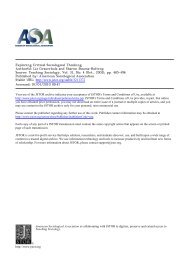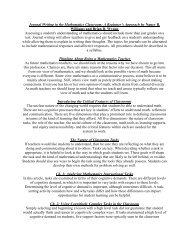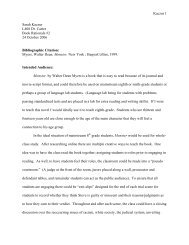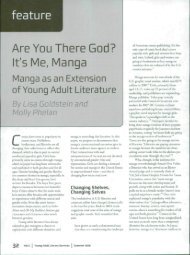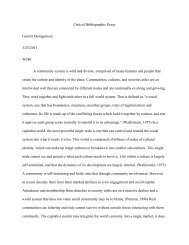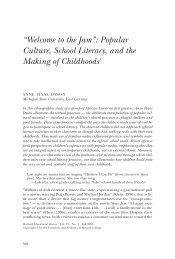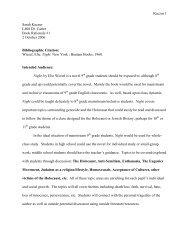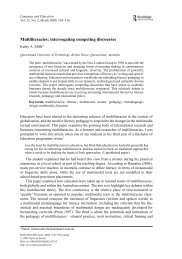A road map for reading specialists entering schools ... - Oncourse
A road map for reading specialists entering schools ... - Oncourse
A road map for reading specialists entering schools ... - Oncourse
You also want an ePaper? Increase the reach of your titles
YUMPU automatically turns print PDFs into web optimized ePapers that Google loves.
I elected to use young adult (YA) literature. Beingfamiliar with specific children's literature—novelswritten by Afriean American authors and novelswith African American characters—I presented theteachers with novels to consider. The goal was toincrease students' engagement with the <strong>reading</strong> materials.It has been suggested that African Americanadolescents in low-level <strong>reading</strong> tracks, particularlythose who live in poverty, need to read, write about,and discuss literature that is culturally relevant(Ladson-Biliings, 1995). Teachers were presentedwith novels that could be mediated to help the studentssubstantiate their existence. I wanted curriculummaterials that would lead the teachers to• Bridge the in-school and out-of-sehool literacyof their students,• Use a culturally in<strong>for</strong>med approach to nurturestudents' cultural competence," Use and discuss rich authentic literature,• Provide wide opportunities <strong>for</strong> <strong>reading</strong>, and• Rethink their curriculum orientations.For example. Slam (Myers, 1996) was selected <strong>for</strong>one teacher because its eontents provided opportunitiesto discuss making sound academie decisionsand the consequences of inappropriate decisionswith an African American teen at the center of thediscussions. Other novels (see Figure 2) were selectedif they could be mediated in similar waysto address students' adolescent and cultural identities.Most, but not all, of the titles were writtenby African American authors or had AfricanAmerican characters.Although the curriculum materials were selected<strong>for</strong> the teachers and suggestions <strong>for</strong> using thenovels were given, the teachers decided when touse the novels. They also determined the focus ofthe classroom discussions. 1 provided the teacherswith feedback during postobservation conferencesand grade-level meetings about ways to activelyengage students in conversations about literature orways to use literature to teach comprehensionstrategies. Over the course of the school year, someof the teachers developed rationale <strong>for</strong> their curriculumchoices in relationship to the students' reactionsand involvement with the materials. By theend of the school year, the teachers were encour-FIGURE2Curriculum materials selected<strong>for</strong> classroom instructionAfrican American literature: Voices in tradition.(1998). New York: Holt Rinehart & Winston.Babbitt, N. (1975). Tuck everlasting. Farrar StrausGiroux.Clements, A. (1996). Frindle. New York: Aladdin.Curtis, C.P. (1995). The Watsons go to Birmingham-1963. New York: Bantam Doubieday.Gregory, D. (1990). Nigger: An autobiography. NewYork: Pocket Books.Hamilton, V. (1990). Cousins. New York: Scholastic.Johnson, A. (1998). Heaven. New York: Aiaddin.Kunjufu, J. (1987). Lessons from history. Chicago:African American Images.Lowry, L. (1989). Number the stars. New York:Yearling.Mead, A. (1998). Junebug and the Reverend. NewYork: Deil Yearling.Myers, W.D. (1988). Scorpions. New York:HarperTrophy.Myers, W.D. (1993). Malcolm X: By any means necessary.New York: Scholastic.Myers, W.D. (1996). Slam. New York: Scholastic.Naylor, P.R. (2000). Shiloh. New York: AladdinNeufeld, J. (1999). Edgar Allan. New York: Penguin.Sachar, L. (1998). Holes. New York: Yearling.Woodson, J. (1994). / hadn't meant to tell you this.New York: Laurel Leaf.Wright, R. (1994). Rites of passage. New York:HarperTrophy.Yep, L. (1995). Hiroshima. New York: Scholastic.aged to seleet curriculum materials <strong>for</strong> the upcomingschool year.Sustaining the momentuniDuring my time as <strong>reading</strong> specialist, the teacherswere engaged in several professional developmentprocesses to sustain the momentum of theprofessional development support. Each teacher'sclassroom was visited an average of three times amonth <strong>for</strong> the enfire duration of the designated twohour<strong>reading</strong> period to observe implementation ofthe literacy framework and to plan additional support.The professional development processes included20-minute postobservation conferencesusually held within 48 hours of a class visit, bi-A <strong>road</strong> <strong>map</strong> <strong>for</strong> <strong>reading</strong> <strong>specialists</strong> <strong>entering</strong> <strong>schools</strong> without exem.plary <strong>reading</strong> programs



